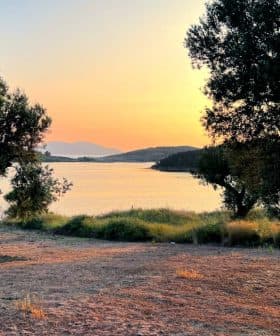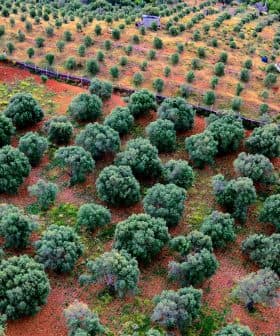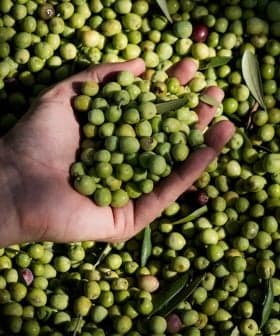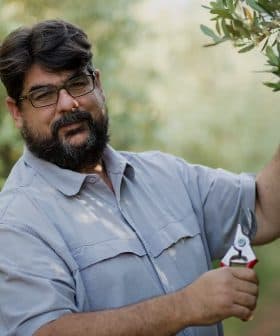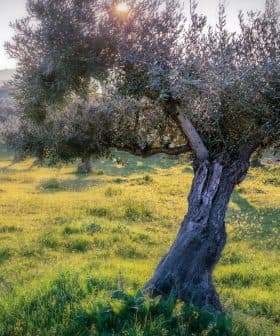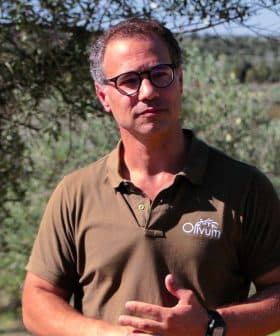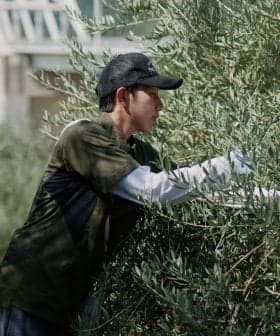Moroccan Producers Anticipate Near-Record Harvest
Olive oil production is expected to reach 200,000 tons for the second time in Morocco. Recently-planted olive trees and improved irrigation are partially responsible.
 Olive plantation and archaeological ruins near Meknes, Morocco
Olive plantation and archaeological ruins near Meknes, Morocco  5.0K reads
5.0K readsProducers in Morocco are expecting a record-tying harvest of 200,000 tons of olive oil in the 2021/22 crop year, which is a significant increase from previous years due to the expansion of olive farming. The country is quickly becoming one of the largest olive oil producers outside of the European Union, with the sector supporting a significant number of employees and contributing to the local economy through exports and quality improvement initiatives.
Producers in Morocco expect a record-tying harvest of 200,000 tons of olive oil in the 2021/22 crop year.
According to provisional data from the International Olive Council (IOC), such a result would vastly exceed the 160,000 tons of the 2020/21 crop year and the 145,000 tons of 2019/2020.
This year, we have suffered a lot of heat until well into the harvest, which made us prolong the irrigation period.
According to the Fédération Interprofessionnelle Marocaine de l’Olive (Interprolive), the 21 percent growth expected in the current crop year over the previous one is due to the constant expansion of olive farming bearing fruit.
Interprolive estimates that the almost 800,000 hectares of olive groves in 2010 have soared to 1.2 million hectares in the current season.
See Also:2021 Harvest Updates“The olive oil production chain has benefited from relevant privileges within the Maroc Vert strategy,” Interprolive director Mohamed Khannoufi wrote in a document reported by L’Opinion.
Maroc Vert, or Green Morocco, is a wide-ranging multi-year agricultural development plan enacted by the government. Supporting agricultural activities, such as olive growing, was among its goals.
According to Juan Vilar Strategic Consultants, the pace of olive farming development is quickly leading the country to be one of the most relevant global producers.
IOC data show how Morocco’s production has steadily increased over the last two decades. It rose from an average of 75,000 tons between 2001 and 2010 to 133,000 tons the following decade. In the last four crop years, Morocco has produced an average of 176,000 tons per annum.
Morocco is quickly becoming one of the largest olive oil producers outside of the European Union, joining the likes of Turkey and Tunisia, which produced 227,500 tons and 240,000 tons, respectively, according to the IOC.
Khannoufi said these figures are a “consequence of the relevant development of surface, production strategies and transformation facilities. As a result, the total yearly fruit production ranges between 1.4 million and 1.9 million tons.”
Today, the sector generates 51 million work-days a year, representing 13 percent of the whole agricultural labor hours in the country. The IOC estimates that once the current olive farm expansion has reached its goals, it could support 300,000 employees in the sector.
Among the challenges for local olive farmers is the country’s hot and arid climate, which necessitated a significant expansion of irrigation services and technologies.
Recently, the Sotradema-Capep consortium announced a new agreement with a Spanish hydro-technology supplier to deploy new advanced irrigation systems in Aoulouz, in the Taroudant province of southern Morocco.
According to technicians involved in the project, the new facilities will allow olive and almond groves to reduce their water usage by 50 percent.
Soussa-Massa, where Taroudant is located, is Morocco’s leading olive oil-producing region, accounting for about one-third of the country’s annual production.
The Moroccan government has also started similar projects in other regions. Among them are Béni Mellal-Khénifra and Grand Casablanca-Settat, which have been affected by the country’s persistent drought. Many of those projects are financed or co-financed by the World Bank.
According to Ministry of Agriculture data, the growing relevance of the olive sector to the local economy is being fueled by the country’s significant table olive and olive oil exports, which are expected to reach 95,000 tons and 28,000 tons, respectively, in the current crop year.
This success is also due to the olive oil quality project enacted in the country with the help of the United Nations Food and Agriculture Organization (FAO) and the European Bank for Reconstruction and Development (EBRD).
Since 2015, the two international institutions have worked with Interprolive to improve the overall quality of the entire production chain.
See Also:North Africans Ate Olives 100,000 Years Ago, Evidence SuggestsWith the support of the European Union, local and international institutions conducted training sessions and olive oil awareness campaigns in the country’s producing regions, with thousands of farmers and millers participating in the courses and events.
“Thanks to hands-on training, olive farmers have learned good management practices, such as pruning techniques that can help prevent pests and disease and reduce extreme yearly yield variations,” the FAO said.
“Processors and millers learned about how the latest extraction technologies can produce premium oils,” the organization added. “Each participant received a checklist of best practices along with a booklet on how extra virgin olive oil should and shouldn’t taste and what can go wrong in the production process to cause defects.”
According to the FAO, fostering an olive oil culture in the country still has a long way to go. For example, only four percent of the more than 1,200 consumers who took part in a survey knew the difference between extra virgin olive oil and non-virgin olive oils.
“In Morocco and elsewhere around the Mediterranean, many consumers have gotten used to highly fermented and oxidized olive oils whose original, natural characteristics have degraded,” Khannoufi said.
“There is work to be done to change consumers’ perception of what constitutes a good olive oil and provide them with clearer, more informative and, above all, trustworthy labels,” he added.
However, Omar Tagnaouti Moummani, the export and development director of Olea, told Olive Times how the popularity of extra virgin olive oil is growing.
“As in the entire Mediterranean basin, olive oil is an ancient and essential ingredient for the Moroccan diet,” he said. “The use is for both raw food and cooking, being present in the kitchens of all homes and restaurants.”
“Regarding the health properties, there is a promotion in the media, although, as a Muslim country, we believe in the benefits of the olive oil, due to the fact that olives and olive oil are mentioned several times in the Holy Quran,” he added.
Tagnaouti Moummani also emphasized how relevant olive oil’s local origins are to promoting its consumption in Morocco.
“One of our goals is to work to promote local varieties, including our beloved Beldi, which produces an intense, round and balanced fruity oil, as well as one of the best table olives in the world,” he said.
Beldi is an olive variety characterized by modest but constant yields with a higher-than-average percentage of olive oil in the drupes. The variety is also very resilient to common pathogens, can withstand intense cold and thrives in highly-saline soil.
“In general, we can say that we have had an average harvest in terms of quantity, with a very good quality,” said Tagnaouti Moummani when describing the current season.
“This year, we have suffered a lot of heat until well into the harvest, which made us prolong the irrigation period,” he concluded. “We try to adapt as best as possible to the changes, controlling both fertigation and pruning.”
Share this article


